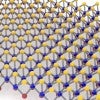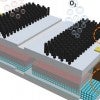
2D sandwich sees molecules with clarity
A 2D platform of molybdenum, sulfur and selenium is adept at detecting biomolecules via surface-enhanced Raman spectroscopy. Its nonmetallic nature helps by curtailing background noise.

2D sandwich sees molecules with clarity
A 2D platform of molybdenum, sulfur and selenium is adept at detecting biomolecules via surface-enhanced Raman spectroscopy. Its nonmetallic nature helps by curtailing background noise.

Rice faculty part of Baylor Superfund program
A $10 million federal grant establishes a center to study how toxic chemicals from Superfund sites impact preterm births.

Water-splitting module a source of perpetual energy
Rice University researchers have integrated high-efficiency solar cells and electrode catalysts into an efficient, low-cost device that splits water to produce hydrogen fuel.

Hidden symmetry found in chemical kinetic equations
Rice University researchers have discovered a hidden symmetry in the chemical kinetic equations scientists have long used to model and study many of the chemical processes essential for life.

Almost gone but never forgotten
Julianne Yost wins this year’s top teaching award, the George R. Brown Prize for Excellence in Teaching.

Rice to offer new master's degree in applied chemical sciences
Rice is offering a new master's degree in applied chemical sciences that combines advanced coursework in science and management with business training and hands-on experience.

Rice wins federal grant to advance sickle cell disease therapy
A Rice University lab has won a prestigious National Institutes of Health grant to pursue gene-editing research it hopes will lead to a cure for sickle cell disease (SCD).

Graduating Mellon Mays fellows grateful for opportunity — and the Rice mentors who helped
Increasing diversity in the faculties of colleges and universities across the U.S. is the mission of the Mellon Mays Undergraduate Fellowship (MMUF) program, which has helped fund the doctoral dreams of over 5,000 students at 48 member schools since 1986.

As the COVID-19 crisis plays out, Rice University faculty have been proactively making the best of a difficult situation for their students.

Heart nanofibers in STAT Madness semifinals
Texas Heart Institute and Rice University’s heart-saving nanotube fibers have advanced to the semifinal round of STAT Madness.

Rice professors named AIMBE fellows
Two Rice University faculty members have been named to the College of Fellows of the American Institute for Medical and Biological Engineering.

Coronavirus and the classroom: How Rice is tackling the move to remote learning
Rice students, faculty and staff are finishing the spring semester in unprecedented circumstances, responding to the threat of COVID-19 by hunkering down and delivering classes online.

Heart nanofibers in STAT Madness quarterfinals
Texas Heart Institute and Rice University’s heart-saving nanotube fibers have advanced to the quarterfinal round of STAT Madness.